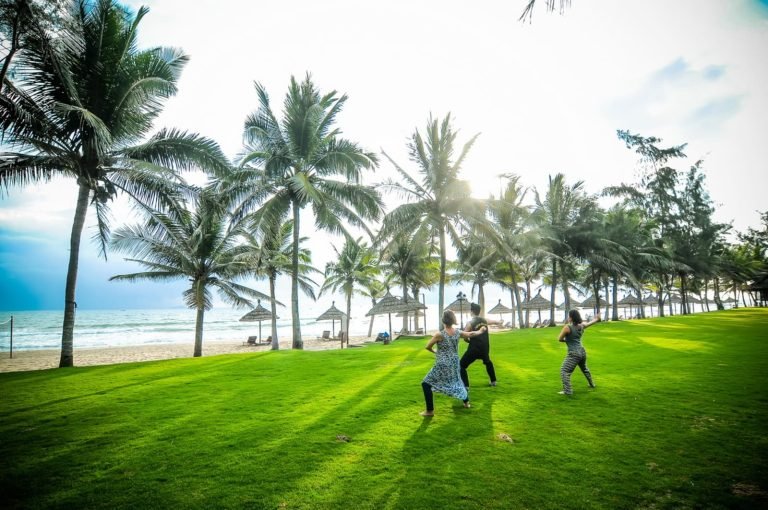The Golden Triangle is one of the most legendary travel destinations in Northern Thailand, known for its mysterious history, stunning river landscapes, and multicultural influence. Once the heart of the opium trade, it has transformed into a peaceful and educational tourism hub, attracting visitors who are fascinated by history, nature, and culture. From historic temples and hill tribe villages to river adventures along the Mekong, the Golden Triangle Thailand offers a unique travel experience unlike any other place in Thailand.
1. Where Is the Golden Triangle?
Golden Triangle, mountainous region in Southeast Asia where the borders of Thailand, Laos, and Myanmar (Burma) meet near the confluence of the Mekong and Ruak rivers. It is located in Chiang Rai Province in far northern Thailand, the exact point of the Golden Triangle is at the confluence of the Mekong and Ruak Rivers, where travelers can stand on Thai soil and view three countries at once.
Descriptions of its size range from 77,220 square miles (200,000 square km) to 370,000 square miles (950,000 square km). Today, the Thai and Laotian areas of the Golden Triangle Chiang Rai are popular tourist destinations known for their beautiful natural scenery, rich culture, and historical significance.
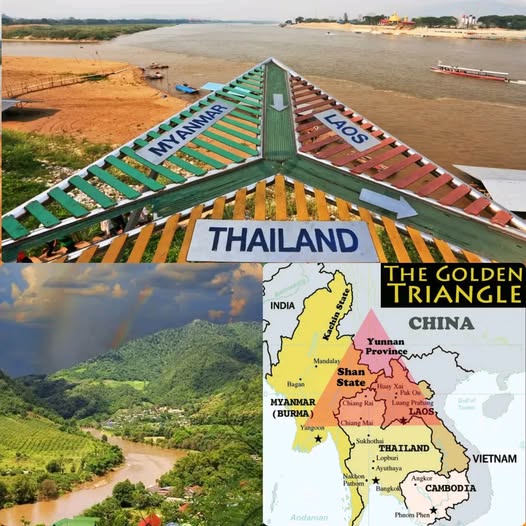
Where Is the Golden Triangle?
2. What Makes the Golden Triangle Special?
The Golden Triangle is more than just a geographic landmark, it has a lot of special things that attracts more and more tourists visiting here:
- It once formed one of the world’s largest opium-producing regions, controlled by powerful trade networks.
- It showcases distinct cultures and ethnic heritages, including Thai, Burmese, Laotian, and hill tribe communities.
- The region offers dramatic river and mountain scenery, ideal for photography and nature lovers. The landscape itself is a testament to the region’s allure, with undulating hills cloaked in lush greenery and meandering riverbanks that paint a picturesque panorama.
- It combines history, museums, temples, and outdoor experiences in one unique location, making a wonderful experience for tourists
- It represents transformation and rehabilitation, shifting from narcotics to tourism, education, agriculture, and conservation that impress tourists at first sight.
Today, the Golden Triangle is a peaceful tourist zone, offering travelers the chance to learn, explore, and enjoy without the commercial hustle of big cities.

What Makes the Golden Triangle Special?
3. Things to do in Golden Triangle
The Golden Triangle Chiang Rai region is filled with meaningful cultural sites, scenic viewpoints, historic temples, and immersive local experiences. Below are the top things to do when visiting this iconic area.
3.1. Hall of Opium Museum
The Hall of Opium is one of Thailand’s most impressive museums, offering an educational and emotional journey into the history of the opium trade in Southeast Asia. Through interactive exhibitions, multimedia presentations, and historic displays, visitors will learn how the opium era shaped local communities and how Thailand transformed its past into sustainable development. It is highly recommended for anyone seeking a deeper understanding of the region.

Hall of Opium Museum
3.2. Golden Triangle Viewpoint
The Golden Triangle Viewpoint is a popular tourist destination in northern Thailand where you can see the borders of Thailand, Laos, and Myanmar meet at the confluence of the Ruak and Mekong rivers. It is located in the Chiang Saen district of Chiang Rai province and is known for its scenic views, cultural sites, and surrounding activities. From this place, tourists can see a panoramic view of the near-by hills and mountains.

Golden Triangle Viewpoint
3.3. Chiang Saen Historical Park
Chiang Saen Historical Park refers to the ancient city of Chiang Saen, located in northern Thailand along the Mekong River, which is filled with ruins of temples and city walls from the Lanna Kingdom. Visitors can stroll through archaeological sites, old city walls, ancient temples, and museum exhibits that showcase the former power of this northern kingdom. It’s perfect for travelers who love history and peaceful exploration.
Visiting there, you cann’t miss these key sites and attractions below:
- Wat Pa Sak Historical Site: One of the most significant archaeological sites, featuring a 12.5-meter-high stupa built in the classic Lanna style. The name translates to “Temple of the Teak Forest” because King Saen Phu planted 300 teak trees there.
- Wat Phra That Chedi Luang: The former main temple of the ancient city, with a large, prominent stupa.
- Ancient City Walls and Gates: The city is bordered by ancient walls and moats, with remnants of the old gates still visible today.
- Chiang Saen National Museum: This museum displays artifacts from the region, including Chiang Saen-style Buddha images, Lanna artifacts, and local ethnic crafts,
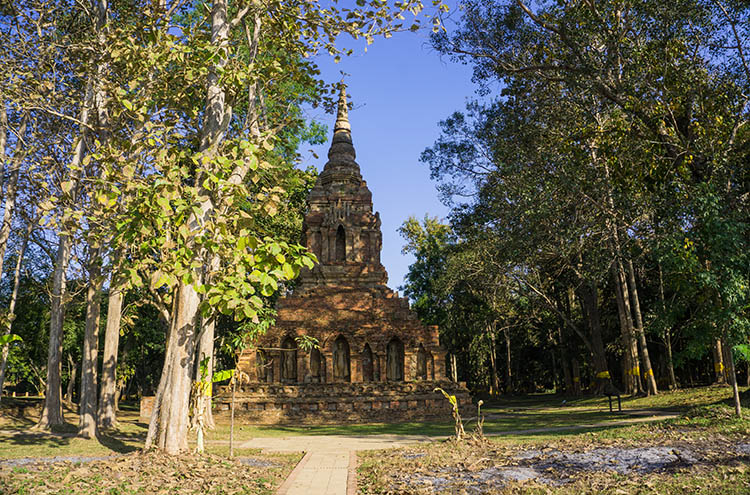
Chiang Saen historical park
3.4. Boat Tours on the Mekong River
A boat trip along the Mekong River is one of the most exciting activities in the Golden Triangle. Tourists will have a chance to take a cruise along borders, observe riverside villages, and view landscapes of three different countries at once. Some tours may include a brief stop at designated market areas (depending on immigration rules and tour type).

Boat Tours on the Mekong River
3.5. Mae Fah Luang Garden (Doi Tung)
Mae Fah Luang Garden is a year-round flower garden with a remarkable history. Once a stopping point for caravans transporting opium, heroin-processing chemicals, and weapons along former trafficking routes, the area has since been transformed into a peaceful, 32-acre landscape garden.
Today, the garden showcases a vibrant array of seasonal blooms, including slipper orchids, cool-climate flowers, diverse ferns, and towering trees that line the hillside. Thoughtfully designed pathways and open spaces make it easy for visitors of all ages to explore the garden and appreciate its beauty up close.
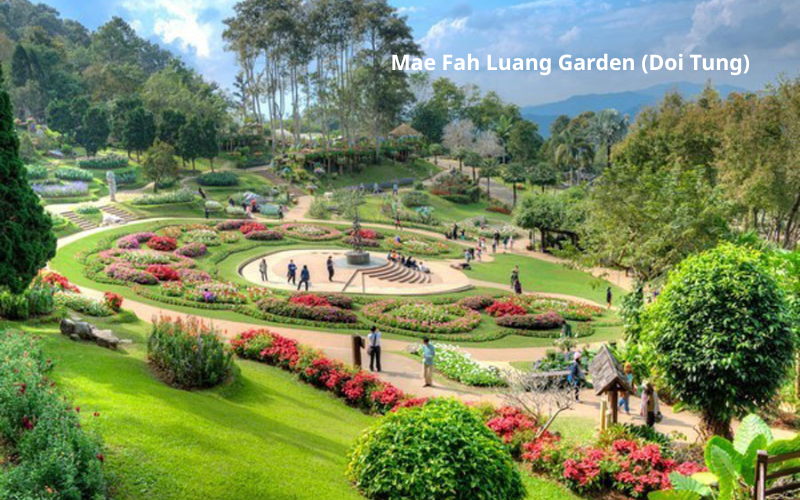
Mae Fah Luang Garden (Doi Tung)
3.6. Wat Phra That Doi Wao
Wat Phra That Doi Wao, set on a hilltop in Mae Sai District, it provides sweeping views of lush countryside, the lively border town below, and the dramatic landscapes of neighboring Myanmar.
The temple’s name, Doi Wao -meaning “Scorpion Hill”- originates from the scorpions that once lived abundantly in the area. Today, the site is celebrated not for its former inhabitants but for its cultural importance and spectacular vistas.
What sets Wat Phra That Doi Wao apart is its elegant blend of Thai and Burmese architectural styles. The temple features ornate carvings and gilded decorations that highlight the exceptional skill of artisans from earlier eras. At the heart of the complex stands the main chedi, a graceful golden stupa that rises prominently against the sky, shimmering brilliantly in the tropical light.

Wat Phra That Doi Wao
3.7. Hill Tribe Village Visits
Visiting Akha, Lahu, Lisu, or Karen communities provides authentic cultural experiences. Travelers can observe traditional crafts, daily life, and tribal customs. Ensure your visit supports ethical and community-based tourism, respecting local traditions.
Tourists will meet Karen people, one of Thailand’s largest hill tribes, are best known for their beautiful handwoven textiles and the famous Long Neck Karen (Padaung) women, who wear stacked brass rings around their necks. They are also skilled in sustainable farming and live in wooden stilt houses, reflecting their deep connection to nature.
Besides, you can see the Hmong Tribe, who are known for their intricate embroidery, colorful clothing, and expertise in highland farming. A visit to a Hmong village offers travelers the chance to observe traditional textile-making techniques, sample organic teas, and learn about their deep-rooted animist beliefs.
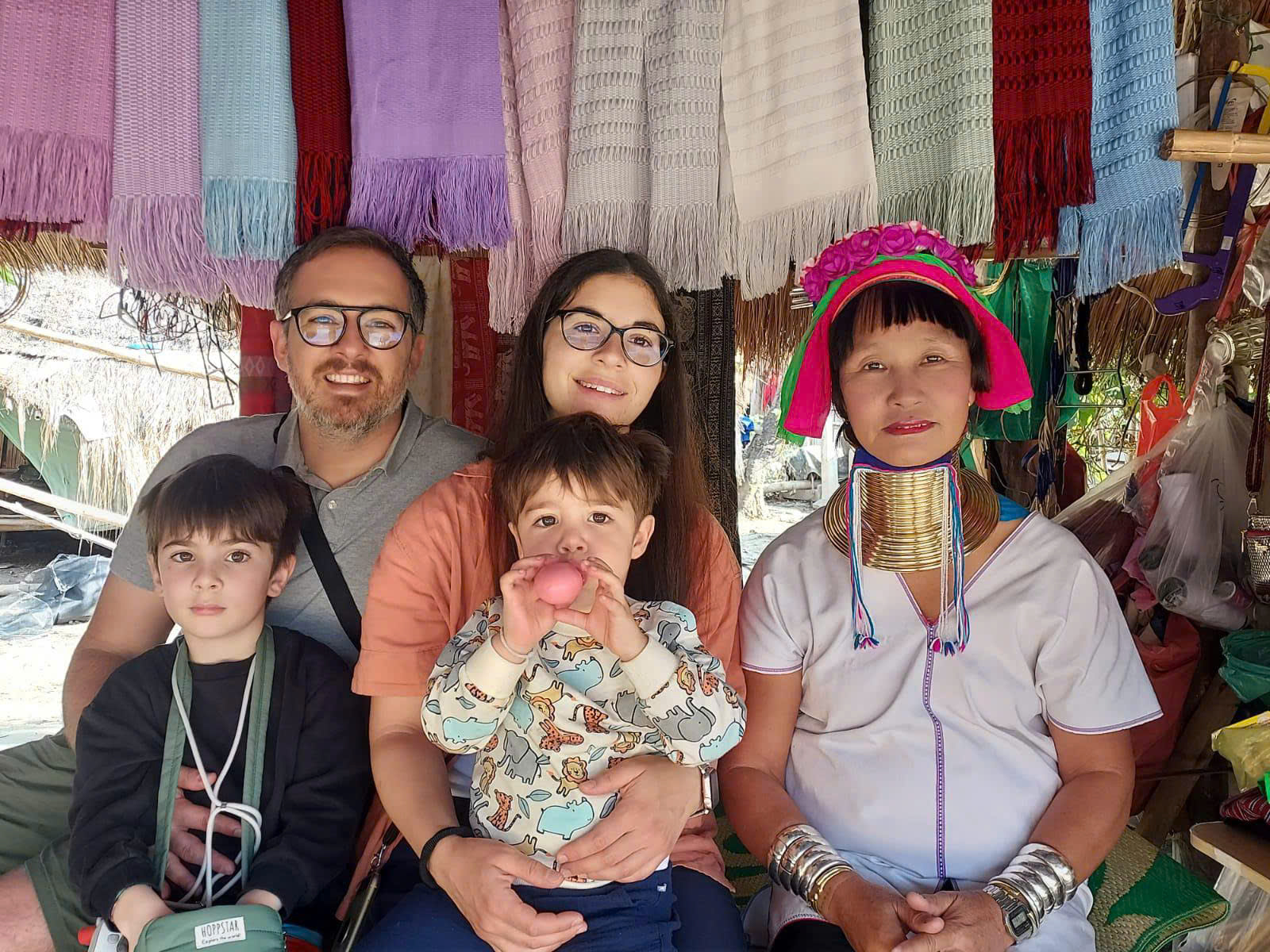
Hill Tribe Village Visits
3.8.The Mae Sai Border Market
The Mae Sai Border Market is one of the most bustling and vibrant spots in the town. As you stroll through the market, you’ll encounter a colorful mix of Thai and Burmese goods. You can shop for inexpensive local products, including handcrafted souvenirs, textiles, jewelry, and even Burmese food items. Don’t miss the variety of inexpensive cigarettes and alcohol, which are a major draw for many visitors. The market offers an authentic border town experience and is a perfect place to purchase unique items at bargain prices.

The Mae Sai Border Market
4. Travel tips to Golden triangle
4.1. Best time to visit Golden Triangle
The best time to visit the Golden Triangle Thailand spans from November to February. During thí time, the weather is pleasant with lower temperatures and minimal rainfall. It’s ideal for tourits to explore the region’s outdoor attractions, interesting activities and cultures.
- From November to February: the weather is cool and dry, it’s also a peak tourist season, providing excellent conditions for sightseeing and outdoor activities.
- March to April :Starting a hot season so the temperature increases up to 35 degrees Celsius. However, it’s less rainy and still possible to visit during this time
- May to October (Rainy Season): The rainy season brings higher humidity and frequent rainfall. During this time, it has lush green landscapes, but heavy rain can disrupt outdoor plans. It’s the low season so the prices may be lower and tourist numbers reduced.
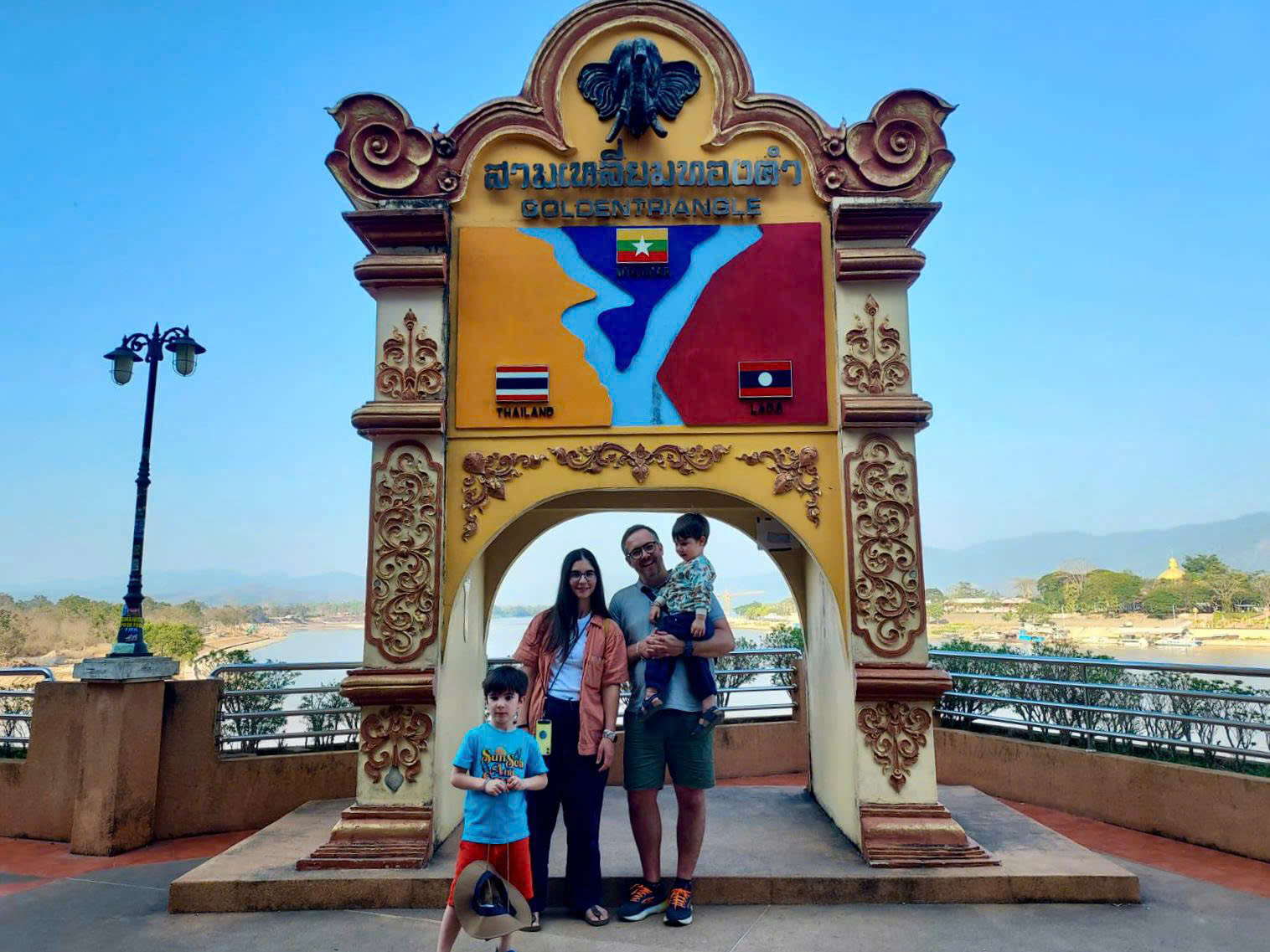
Best time to visit Golden Triangle
4.2. How to get Golden triangle
Getting to the Golden Triangle, tourists will get there with a combination of air travel, ground transportation, and possibly boat trips, depending on your specific itinerary. Starting the trip, you can book a flight to Chiang Rai International Airport and then you can find transportation options such as taxis, private cars, and shuttle services to take you to your accommodation in Chiang Rai or directly to the Golden Triangle area. Travel from Chiang Rai to the Golden Triangle area by car, it will take you around 1 to 1.5 hours, depending on your specific destination within the Golden Triangle.
If travellers want to have a new experience, consider taking a boat trip along the Mekong River to explore the Golden Triangle region. Some tours and cruises offer scenic journeys along the river, providing a unique perspective of the area where the borders of Thailand, Laos, and Myanmar meet.

How to get Golden triangle
4.3. How many days do you spend for this tour to Golden Triangle?
A 3-day trip is ideal for exploring the Golden Triangle in Southeast Asia comfortably and fully appreciating its historical, cultural, and natural attractions. With three days, you can enjoy a balanced mix of museums, scenic viewpoints, river activities, temples, gardens, and local communities without feeling rushed. It also allows time for cultural immersion, relaxing moments, and meaningful experiences beyond the main landmarks.
Here’s a suggested 3-day itinerary overview:
Day 1:
- Travel from Chiang Rai
- Visit the Golden Triangle Viewpoint
- Explore Hall of Opium Museum
- Enjoy Mekong River boat ride
Day 2:
- Discover Chiang Saen Historical Park
- Explore Wat Phra That Doi Wao and nearby temples
- Visit a hill tribe village cultural experience
Day 3:
- Tour Mae Fah Luang Garden and Doi Tung area
- Relax with scenic views, cafés, or nature walks
- Return to Chiang Rai or continue to Chiang Mai
This duration gives you enough time to absorb the local culture, learn the history deeply, enjoy sightseeing at a slower pace, and appreciate the beauty of Northern Thailand.
Conclusion
The Golden Triangle is a truly unique destination, well worth a visit for anyone interested in experiencing the region’s rich culture, fascinating history, and breathtaking landscapes. It offers travelers a remarkable blend of natural beauty and cultural depth, making it an unforgettable place to explore.
Ready to experience the wonders of the Golden Triangle with Asia Viva Travel? With expert guides, seamless planning, and personalized itineraries, your journey through this culturally rich and visually stunning region will be unforgettable.














